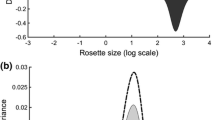Abstract
The identification of the demographic processes responsible for the decline in population growth rate (λ) in disturbed areas would allow conservation efforts to be efficiently directed. Integral projection models (IPMs) are used for this purpose, but it is unclear whether the conclusions drawn from their analysis are sensitive to how functional structures (the functions that describe how survival, growth and fecundity vary with individual size) are selected. We constructed 12 IPMs that differed in their functional structure by combining two reproduction models and three functional expressions (generalized linear, cubic and additive models), each with and without simplification. Models were parameterized with data from two populations of two endangered cacti subject to different disturbance intensities. For each model, we identified the demographic processes that most affected λ in the presence of disturbance. Simulations were performed on artificial data and analyzed as above to assess the generality of the results. In both empirical and simulated data, the same processes were identified as making the largest contribution to changes in λ regardless of the functional structure. The major differences in the results were due to misspecification of the fecundity functions, whilst functional expression and model simplification had lesser effects. Therefore, as long as the demographic attributes of the species are well known and incorporated into the model, IPMs will robustly identify the processes that most affect the growth of populations subject to disturbance, making them a reliable tool for developing conservation strategies.




Similar content being viewed by others
References
Arias-Montes S, Guzmán U, Gama S (1997) Cactaceae. Flora del Valle de Tehuacán-Cuicatlán, México, Fascículo 14. Instituto de Biología. Universidad Nacional Autónoma de México, México
Bhattacharyya A (1946) On a measure of divergence between two multinomial populations. Sankhya Indian J Stat 7:401–406
Buhl-Mortensen L (1996) Type-II statistical errors in environmental science and the precautionary principle. Mar Pollut Bull 32:528–531
Burnham KP, Anderson DR (2002) Model selection and multimodel inference: a practical information-theoretic approach. Springer, New York
Carpenter SR, Caraco NF, Correll DL, Howarth RW, Sharpley AN, Smith VH (1998) Nonpoint pollution of surface waters with phosphorus and nitrogen. Ecol Appl 8:559–568
Caswell H (2000) Prospective and retrospective perturbation analyses: their roles in conservation biology. Ecology 81:619–627
Caswell H (2001) Matrix population models: construction, analysis, and interpretation. Sinauer, Sunderland
Chapin FS III, Zavaleta ES, Eviner VT, Naylor RL, Vitousek PM, Reynolds HL, Hooper DU, Lavorel S, Sala OE, Hobbie SE, Mack MC, Díaz S (2000) Consequences of changing biodiversity. Nature 405:234–242. doi:10.1038/35012241
Childs DZ, Rees M, Rose KE, Grubb PJ, Ellner SP (2003) Evolution of complex flowering strategies: an age- and size-structured integral projection model. Proc R Soc Lond B 270:1829–1838. doi:10.1098/rsb.2003.2399
Dahlgren JP, Ehrlén J (2009) Linking environmental variation to population dynamics of a forest herb. J Ecol 97:666–674. doi:10.1111/j.1365-2745.2009.01504.x
Dahlgren JP, Ehrlén J (2011) Incorporating environmental change over succession in an integral projection model of population dynamics of a forest herb. Oikos 120:1183–1190. doi:10.1111/j.1600-0706.2010.19063.x
Dahlgren JP, García MB, Ehrlén J (2011) Nonlinear relationships between vital rates and state variables in demographic models. Ecology 92:1181–1187. doi:10.1890/10-1184.1
De Kroon H, van Groenendael J, Ehrlén J (2000) Elasticities: a review of methods and model limitations. Ecology 81:607–618. doi:10.1890/0012-9658(2000)081[0607:EAROMA]2.0.CO;2
Easterling MR, Ellner SP, Dixon PM (2000) Size-specific sensitivity: applying a new structured population model. Ecology 81:694–708. doi:10.1890/0012-9658(2000)081[0694:SSSAAN]2.0.CO;2
Ehrlén J, Van Groenendael J (1998) Direct perturbation analysis for better conservation. Conserv Biol 12:470–474. doi:10.1111/j.1523-1739.1998.96420.x
Ellner SP, Rees M (2006) Integral projection models for species with complex demography. Am Nat 167:410–428. doi:10.1086/499438
Enright NJ, Franco M, Silvertown J (1995) Comparing plant life-histories using elasticity analysis: the importance of life-span and the number of life-cycle stages. Oecologia 104:79–84. doi:10.1007/BF00365565
Franco M, Silvertown J (2004) A comparative demography of plants based upon elasticities of vital rates. Ecology 85:531–538. doi:10.1890/02-0651
Godínez-Álvarez H, Valverde T, Ortega-Baes P (2003) Demographic trends in the Cactaceae. Bot Rev 69:173–203. doi:10.1663/0006-8101(2003)069[0173:DTITC]2.0.CO;2
Goudie A (2006) The human impact on the natural environment: past, present, and future. Blackwell, Malden
Gray JS (1990) Statistics and the precautionary principle. Mar Pollut Bull 21:174–176
Gross K, Morris WF, Wolosin MS, Doak DF (2006) Modeling vital rates improves estimation of population projection matrices. Popul Ecol 48:79–89. doi:10.1007/s10144-005-0238-8
Haller S (2000) A prudential argument for precaution under uncertainty and high risk. Ethics Environ 5:175–189
Hanson M (2003) The precautionary principle. In: Page EA, Proops J (eds) Environmental thought. Current issues in ecological economics. Edward Elgar, Northampton, pp 125–142
Hegland SJ, Jongejans E, Rydgren K (2010) Investigating the interaction between ungulate grazing and resource effects on Vaccinium myrtillus populations with integral projection models. Oecologia 163:695–706. doi:10.1007/s00442-010-1616-2
Heywood VH, Iriondo JM (2003) Plant conservation: old problems, new perspectives. Biol Conserv 113:321–335. doi:10.1016/S0006-3207(03)00121-6
Jiménez-Sierra C, Mandujano MC, Eguiarte LE (2007) Are populations of the candy barrel cactus (Echinocactus platyacanthus) in the desert of Tehuacan, Mexico at risk? Population projection matrix and life table response analysis. Biol Conserv 135:278–292. doi:10.1016/j.biocon.2006.10.038
Jongejans E, Shea K, Skarpaas O, Kelly D, Ellner SP (2011) Importance of individual and environmental variation for invasive species spread: a spatial integral projection model. Ecology 92:86–97. doi:10.1890/09-2226.1
Kriebel D, Tickner J, Epstein P, Lemons J, Levins R, Loechler EL, Quinn M, Rudel R, Schettler T, Stoto M (2001) The precautionary principle in environmental science. Environ Health Perspect 109:871–876
Martorell C (2007) Detecting and managing an overgrazing-drought synergism in the threatened Echeveria longissima (Crassulaceae): the role of retrospective demographic analysis. Popul Ecol 49:115–125. doi:10.1007/s10144-006-0027-z
Martorell C, Peters EM (2005) The measurement of chronic disturbance and its effects on the threatened cactus Mammillaria pectinifera. Biol Conserv 124:199–207. doi:10.1016/j.biocon.2005.01.025
Martorell C, Peters EM (2009) Disturbance-response analysis: a method for rapid assessment of the threat to species in disturbed areas. Conserv Biol 23:377–387. doi:10.1111/j.1523-1739.2008.01134.x
McAuliffe JR, Sundt PC, Valiente-Banuet A, Casas A, Viveros JL (2001) Pre-columbian soil erosion, persistent ecological changes, and collapse of a subsistence agricultural economy in the semi-arid Tehuacan Valley, Mexico’s ‘Cradle of Maize’. J Arid Environ 47:47–75. doi:10.1006/jare.2000.0691
McGarvey DJ (2007) Merging precaution with sound science under the endangered species act. Bioscience 57:65–70. doi:10.1641/B570110
Metcalf JE, Horvitz CC, Tuljapurkar S, Clark DA (2009) A time to grow and a time to die: a new way to analyze the dynamics of size, light, age, and death of tropical trees. Ecology 90:2766–2778
Pérez-Negrón E, Casas A (2007) Use, extraction rates and spatial availability of plant resources in the Tehuacan-Cuicatlan Valley, Mexico: the case of Santiago Quiotepec, Oaxaca. J Arid Environ 70:356–379. doi:10.1016/j.jaridenv.2006.12.016
R Development Core Team (2010) R: a language and environment for statistical computing. R Foundation for Statistical Computing, Vienna
Ramula S, Rees M, Buckley YM (2009) Integral projection models perform better for small demographic data sets than matrix population models: a case study of two perennial herbs. J Appl Ecol 46:1048–1053. doi:10.1111/j.1365-2664.2009.01706.x
Redford KH, Richter BD (1999) Conservation of biodiversity in a world of use. Conserv Biol 13:1246–1256
Rees M, Ellner SP (2009) Integral projection models for populations in temporally varying environments. Ecol Monogr 79:575–594. doi:10.1890/08-1474.1
Rees M, Rose KE (2002) Evolution of flowering strategies in Oenothera glazioviana: an integral projection model approach. Proc R Soc Lond B 269:1509–1515. doi:10.1098/rspb.2002.2037
Shahabuddin G, Kumar R (2006) Influence of anthropogenic disturbance on bird communities in a tropical dry forest: role of vegetation structure. Anim Conserv 9:404–413. doi:10.1111/j.1469-1795.2006.00051.x
Silvertown J, Franco M, Pisanty I, Mendoza A (1993) Comparative plant demography: relative importance of life-cycle components to the finite rate of increase in woody and herbaceous perennials. J Ecol 81:465–476
Singh SP (1998) Chronic disturbance, a principal cause of environmental degradation in developing countries. Environ Conserv 25:1–2
Soulé ME, Kohm KA (1989) Research priorities for conservation biology. Island Press, Washington, DC
Ureta C, Martorell C (2009) Identifying the impacts of chronic anthropogenic disturbance on two threatened cacti to provide guidelines for population-dynamics restoration. Biol Conserv 142:1992–2001. doi:10.1016/j.biocon.2008.12.031
Vitousek PM, Mooney HA, Lubchenco J, Melillo JM (1997) Human domination of Earth’s ecosystems. Science 277:494–499
Wood SN (2003) Thin plate regression splines. J R Stat Soc B 65:95–114. doi:10.1111/1467-9868.00374
Wood SN (2006) Generalized additive models: an introduction with R. Chapman & Hall/CRC, Boca Raton
Zuidema PA, Jongejans E, Chien PD, During HJ, Schieving F (2010) Integral Projection Models for trees: a new parameterization method and a validation of model output. J Ecol 98:345–355. doi:10.1111/j.1365-2745.2009.01626.x
Acknowledgments
B.A. Santini, C. Ureta, V. Tinoco and A. Martínez-Ballesté helped us during the fieldwork. E.J.G. thanks the National Council of Science and Technology (CoNaCyT) for the grant received during his PhD studies and the Graduate Program in Biological Sciences of the National Autonomous University of Mexico (UNAM). We appreciate the valuable comments provided by two anonymous reviewers. We thank the community of Concepción Buenavista for their invaluable support in allowing us to work on their land. This research was carried out in compliance with the laws of Mexico.
Conflict of interest
We declare that we have no conflict of interest.
Author information
Authors and Affiliations
Corresponding author
Additional information
Communicated by Miguel Franco.
Electronic supplementary material
Below is the link to the electronic supplementary material.
Rights and permissions
About this article
Cite this article
González, E.J., Rees, M. & Martorell, C. Identifying the demographic processes relevant for species conservation in human-impacted areas: does the model matter?. Oecologia 171, 347–356 (2013). https://doi.org/10.1007/s00442-012-2432-7
Received:
Accepted:
Published:
Issue Date:
DOI: https://doi.org/10.1007/s00442-012-2432-7




